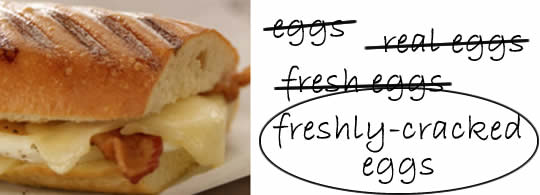Adjective Power
Compelling, emotion-rich adjectives can give bland copy a major boost in effectiveness. (Just like the start of that sentence!) I was reminded of this while viewing a Panera menu. Which do you think sounds more appealing:
Ham, egg, & cheese on wheat bread sandwich.
or,
Our Breakfast Power Sandwich starts with lean, hardwood-smoked ham and a freshly cracked egg. Then we add Vermont white cheddar for its tangy sharpness. Finally, we grill everything on our freshly baked whole grain bread to bring out the grains’ nutty, smooth flavors.
Take a look at the adjectives that turn an average sandwich into a mouth-watering, tantalizing sales magnet:
Our Breakfast Power Sandwich starts with lean, hardwood-smoked ham and a freshly cracked egg. Then we add Vermont white cheddar [cheese] for its tangy sharpness. Finally, we grill everything on our freshly baked whole grain bread to bring out the grains’ nutty, smooth flavors.
If people aren’t lining up to buy this sandwich, it’s not the copy writer’s fault. (Sadly for Panera, though, most patrons only see the mimimalist description on the in-restaurant menu board.)
In Neuro-Menus and Restaurant Psychology, I mention adjectives as a key element of menu psychology. But do adjectives really work?
Adjectives Boost Sales
Properly used adjectives actually DO increase revenue:
Other research by Dr. [Brian] Wansink found that descriptive menu labels increased sales by as much as 27 percent. He has divided descriptions into four categories: geographic labels like “Southwestern Tex-Mex salad,” nostalgia labels like “ye old potato bread,” sensory labels like “buttery plump pasta” and brand names. Finding that brand names help sales, chains are increasingly using what is known as co-branding on their menus, like the Jack Daniel’s sauce at T.G.I. Friday’s and the Minute Maid orange juice on the Huddle House menu, Dr. Wansink said.
Dr. Wansink said that vivid adjectives can not only sway a customer’s choice but can also leave them more satisfied at the end of the meal than if they had eaten the same item without the descriptive labeling. [From NY Times – Using Menu Psychology to Entice Diners by Sarah Kershaw.]
Beyond Food Adjectives
While we can likely all agree that “applewood-smoked bacon” is more enticing than than plain old “bacon,” most of us don’t run restaurants. Still, we can learn from what those food establishments have found to be effective. When it makes sense, enhance the impact of your descriptive copy with carefully chosen adjectives. I’ll offer my own variation on Wansink’s categories of modifiers:
- Vivid – “Freshly-cracked” is much more compelling than “fresh.”
- Sensory – Terms like “hickory-smoked,” “brick oven fired,” “oven-crisped,” etc. engage the reader’s senses.
- Emotional/Nostalgic – “Aged Vermont cheddar” evokes images of crusty New England dairymen rather than Kraft mega-plants.
- Specific – “Wild Alaskan” attached to a salmon description immediately enhances it with visions of vigorous, healthy fish swimming in pristine, unpolluted streams, whatever the reality may be.
- Branded – Attaching desirable brand names to a description can boost sales. I’m sure it hasn’t been cheap for restaurants to offer “Jack Daniels” barbecue items, but their continued menu presence suggests such branding more than pays for itself.
I’d guess these adjectives are processed unconsciously most of the time. Do you really ponder whether the tomato on your burger is “farm-fresh” as the menu claims? What does “farm-fresh” mean, anyway? Do some restaurants use tomatoes that don’t come from farms, or that are so old as to be inedible? (More likely, the tomatoes are so “fresh” that they started green, had to be ethylene-ripened, and still are as hard as croquet balls!) While your conscious mind is thinking about the price, how much money is in your wallet, and whether the item fits your diet, those sensory and emotional terms are being processed in background.
Your own challenge is to find the adjectives that work for your product or service. What emotions do you want to evoke in your customers? A feeling of, say, tradition and craftsmanship? Or cutting-edge technology? Personal service? Find relevant, compelling adjectives, and your copy will be more effective.
Striking a balance
In your quest to liven up your copy, don’t go overboard. As enticing as the Panera sandwich description is, most of us would hate to read more than a paragraph written in that style. As poster Jason Cohen notes on Brian Clark’s Copyblogger, in 10 Secrets to More Magnetic Copy, “Most adjectives and adverbs don’t add information; they just take up space and dull your message.” That’s particularly true if they are boring words that add little in the way of sensory or emotional engagement. But it’s certainly possible to overdo things with vivid modifiers, too. Use them in short product descriptions and similar places, but leave them out of your call to action, your ordering instructions, and anyplace else where easy comprehension is critical.
I trust you’ll find this to be timely, useful, relevant, and actionable advice.

